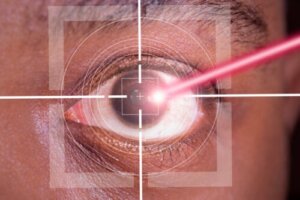Advantages and Disadvantages of LASIK Surgery

Today’s article is about the advantages and disadvantages of LASIK surgery. This procedure can correct visual alterations of the refractive media of the eyeball. This means people can stop wearing eyeglasses or contact lenses.
The eye’s refractive media, such as the lens and cornea, can reflect light rays correctly onto the retina in patients without alterations. However, the cornea deflects it incorrectly in people with myopia, hyperopia, and astigmatism.
LASIK (laser-assisted in situ keratomileuses) is a surgical procedure with good results in the correction of refractive alterations. In addition, it’s an excellent alternative to conventional lenses.
Who needs laser eye surgery?
LASIK is currently used as a secondary and long-term treatment for light refraction defects on the retina. Patients who require this procedure usually manifest the following visual disturbances:
- Myopia
- Hyperopia
- Astigmatism
This procedure is usually recommended by the specialist physician after evaluating the condition and characteristics of the eyeball. However, LASIK surgery isn’t suitable for everyone. In fact, the American Academy of Ophthalmology establishes the following requirements for candidate selection:
- A patient must be 18 years of age or older (21 is the ideal age)
- They’ve experienced table ocular refraction during the last 12 months
- They have a refractive disorder that LASIK can correct
- Finally, their corneas are healthy, thick, and have a correctable visual acuity greater than 6/18
Likewise, it’s essential for the patient not to have ocular and systemic conditions that either make the procedure difficult or compromise long-term health — cataracts, keratoconus, keratitis, or advanced glaucoma. Also, a study establishes a history of strabismus or amblyopia among the relative contraindications.

Preparing for the procedure
LASIK laser eye surgery is an outpatient surgical procedure that usually lasts 15 to 30 minutes. However, it’s still a body invasion, not to be taken lightly.
Some recommendations to take into account when opting for this procedure are:
- Evaluate expectations by discussing them with an ophthalmologist who can explain the most likely results. Most patients should continue to wear glasses when reading or driving at night after surgery.
- Be prepared for the cost as LASIK surgery is outpatient and elective and not usually covered by insurance companies. In this respect, it’s crucial to find out the cost and make sure you have the resources for it.
- Have someone come along and take you back home as your vision won’t be completely adapted or recovered at the end of the procedure.
- Avoid the use of cosmetics like makeup, creams, or lotions near the eyes on the day of surgery. In fact, the ophthalmologist may suggest a cleaning routine for the eyeball and its attachments the days prior to it.
- Anxiety is inevitable but try to remain calm by clearing alarming thoughts from your mind. Focus instead on the benefits the surgery will offer in the long run.
What’s laser eye surgery like?
This kind of procedure usually takes place in an ophthalmologist’s office or in a surgery center. First, they’ll probably explore the eyeball in detail so as to evaluate the refractive elements and establish the course of action to follow.
Once at the center, the specialist will explain the procedure and guide you to the operating room. Inside the center, the staff will ask you to lie down in a reclining chair while looking up. The doctor may administer a painkiller or anesthetic if you’re too nervous.
To begin with, they’ll put anesthetic eye drops on the eyeball, which will reduce discomfort during the procedure. Then, the specialist will place a speculum and a small suction ring that’ll hold the eye open and keep you from blinking.
Using a small laser or microkeratome, the surgeon will make a cut in the cornea and create a flap. Subsequently, the doctor will fold the small flap back to gain access to the structures to repair.
The specialist will reshape parts of the cornea with a programmed laser. In the end, they’ll place back the flap of tissue removed at the beginning. It’ll adhere on its own in a matter of seconds and heal without the need for stitches.
During the procedure, the doctor will ask you to fix your eyes on a point of light in order to avoid eye movement as much as possible. Likewise, it’s possible to recognize a slight odor at the beginning of the corneal reshaping. Most patients think it smells like burnt hair.
The surgeon will follow the above procedure individually, on each eyeball, if both eyes need correction. They usually schedule them on the same day.
Read about How to Detect Astigmatism in Children
Recovery
Patients usually experience discomfort such as burning, dryness, or itching of the eyeball right after the completion of LASIK surgery. For this, the specialist will prescribe ophthalmic drops to lubricate the eyes and reduce the discomfort.
The doctor will usually place a protective shield over the eye or request the use of one when sleeping to facilitate the healing process. In addition, you must relax and rest after the procedure.
The recovery and stabilization of your eyesight will be gradual, so you’ll experience the actual results after a period of two or three months. For this, the doctor will probably arrange several subsequent appointments for re-evaluation and follow-up.
It’s important to take a couple of weeks to return to normal daily activities, especially if you practice extreme sports or swimming. Skip the use of eye cosmetics for a reasonable period of time.
The benefits of LASIK surgery
The main advantage of this procedure lies in the possibility of performing all daily activities without the need for corrective eyeglasses or contact lenses. In fact, 90% of people obtain 20/20 and 20/40 vision without glasses after surgery.
It’s an effective procedure with demonstrated rapid postoperative stabilization, superior to other interventions of the same type. In addition, there’s a low number of complications such as corneal opacities or cataracts.
Successful results are inversely related to the degree of initial ocular involvement. Therefore, the prognosis will be more favorable if there’s a low level of refractory damage.

Read Everything You Need to Know about Visual Impairment
Possible risks and disadvantages of the LASIK surgery
As with any other surgical procedure, LASIK surgery can also cause side effects and complications. Most conditions are temporary and usually disappear in a matter of weeks or months.
Some of the most common secondary manifestations associated with LASIK are:
- Eye pain
- Dry eyes
- Blurred vision
- Burning or stinging in the eye
- Discomfort or sensitivity to direct light
- Colored rings around the lights
- Red eyes
- Infection of the eye
The surgery has led to unfavorable corrections with worse visual results than before the intervention, even with magnifying lenses in some patients.
Likewise, the procedure may trigger loss of vision and permanent vision changes but this is quite rare.
LASIK surgery is an elective procedure not suitable for everyone
This is one of the procedures with the highest success rate in the correction of refractive disorders. However, you must evaluate the pros and cons when performing this type of intervention.
Therefore, don’t undergo refractive surgery if it isn’t too uncomfortable to use glasses without major consequences. It’s important to talk to an ophthalmologist who can answer any questions you might have and discuss the options that best suit your individual needs.
All cited sources were thoroughly reviewed by our team to ensure their quality, reliability, currency, and validity. The bibliography of this article was considered reliable and of academic or scientific accuracy.
- Miranda Hernández I, Barroso Lorenzo R, Perea Hevia L, Ramos Perera Y. Selección del paciente para cirugía refractiva: actualización. Rev Cubana Oftalmol. 2015; 28 (3).
- Moreno R, Srur M, Nieme C. Cirugía refractiva: indicaciones, técnicas y resultados. Revista Médica Clínica Las Condes. 2010;21(6):901-910.
- Lawless M, Hodge C. LASIK. Int Ophthalmol Clin. 2013 Winter;53(1):111-28.
- Wilkinson JM, Cozine EW, Kahn AR. Refractive Eye Surgery: Helping Patients Make Informed Decisions About LASIK. Am Fam Physician. 2017 May 15;95(10):637-644.
- Tse SM, Farley ND, Tomasko KR, Amin SR. Intraoperative LASIK Complications. Int Ophthalmol Clin. 2016 Spring;56(2):47-57.
- LASIK: What You Should Know. Am Fam Physician. 2017 May 15;95(10):Online.
This text is provided for informational purposes only and does not replace consultation with a professional. If in doubt, consult your specialist.








